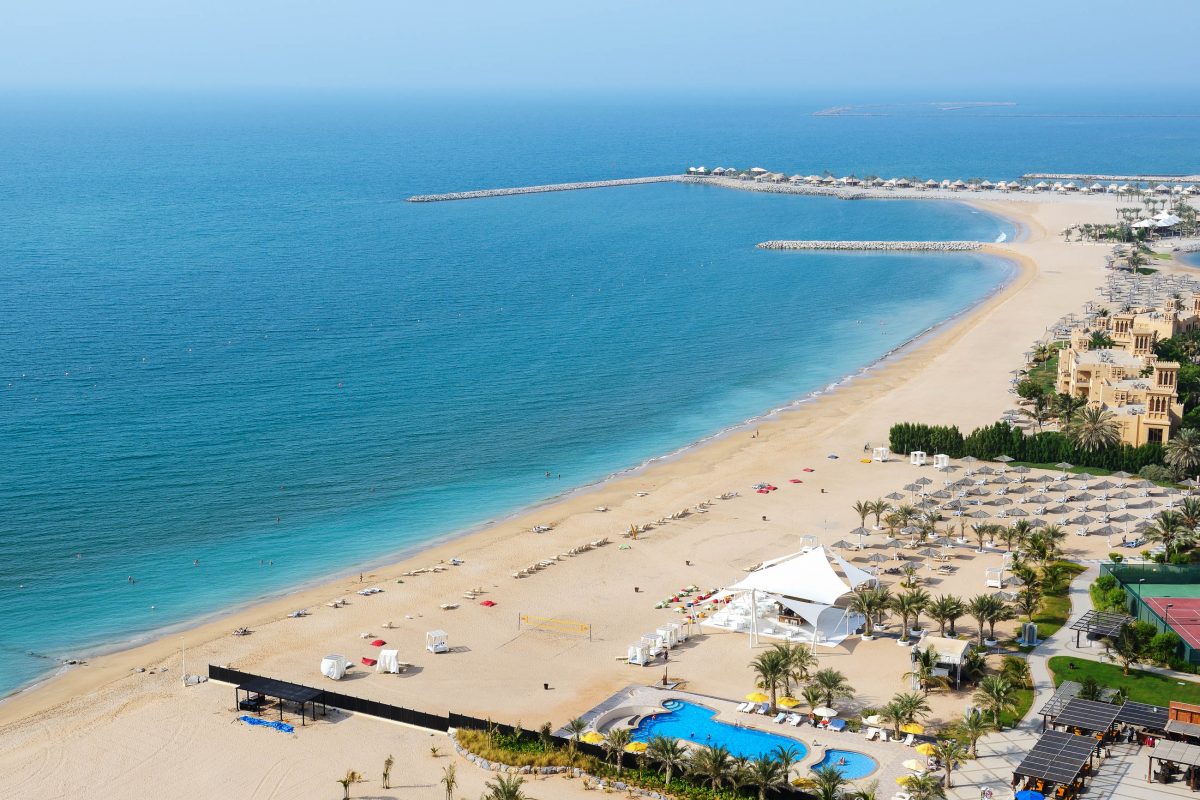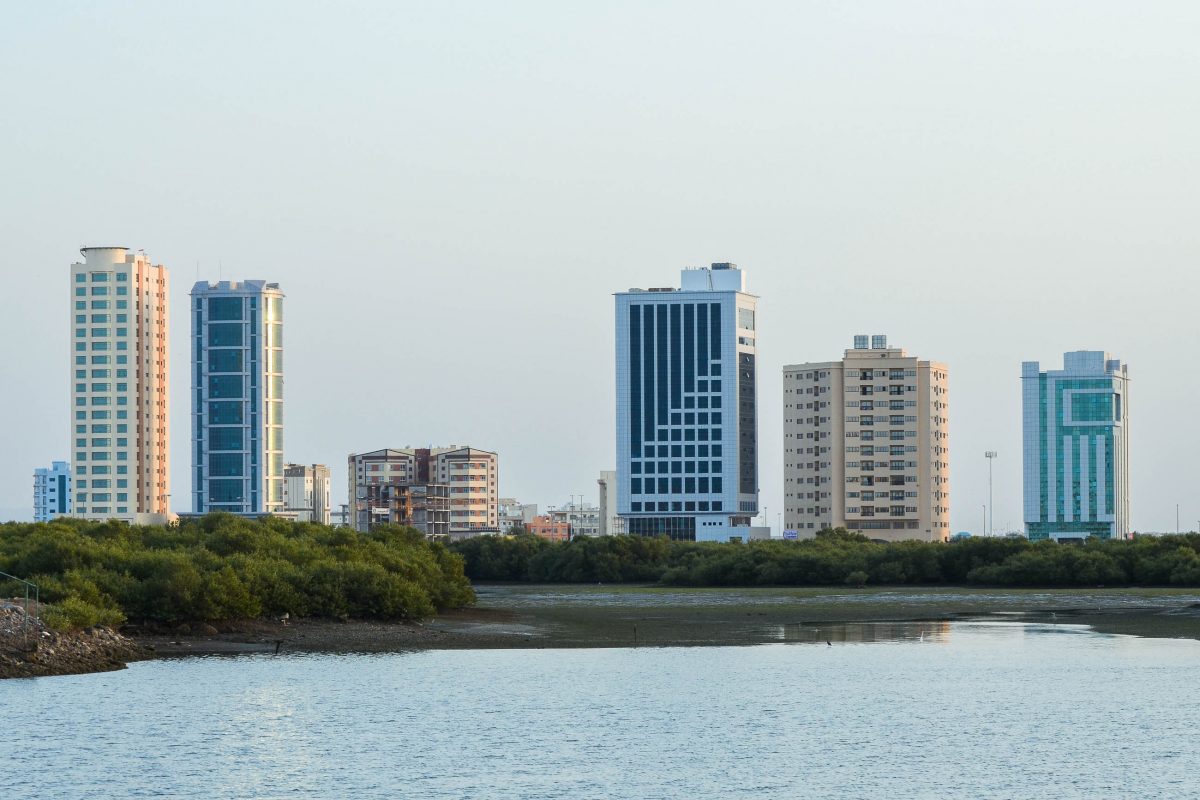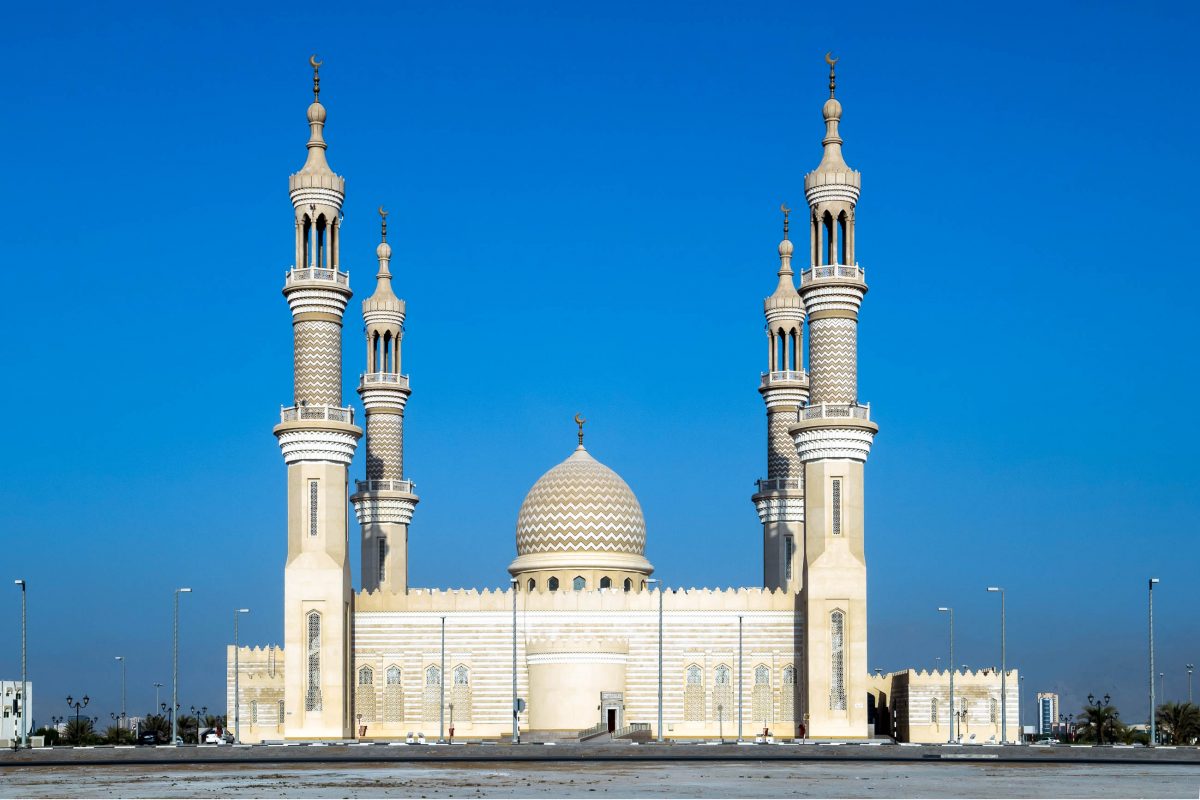Das Emirat Ras al Khaimah ist im Gegensatz zu den bekannteren Emiraten der VAE ruhig, gemütlich und überschaubar geblieben und bietet typisch arabisches Flair zum (noch) günstigen Preis.
Das Emirat Ras al Khaimah („Spitze des Zeltes“) liegt im Nordosten der Vereinigten Arabischen Emirate und kann über den internationalen Flughafen in der gleichnamigen Hauptstadt erreicht werden. Es besteht aus zwei getrennten Regionen, zwischen denen sich das Emirat Fujairah befindet, und wird im allgemeinem Sprachgebrauch oft als „RAK“ bezeichnet.
Inhaltsverzeichnis
BILDER: Ras al Khaimah
Flora und Fauna von Ras al Khaimah
Ras al Khaimah ist im Gegensatz zu den anderen Emiraten aufgrund der Niederschläge im Hadschar-Gebirge des Hinterlandes verhältnismäßig fruchtbar. Vor allem in den Trockensavannen der Küstengebiete gedeihen großflächige Datteln- und Orangenplantagen und an den idyllischen Lagunen, die mit Mangrovenwälder bewachsen sind, finden zahlreiche Fische und Vögel einen geschützten Zufluchtsort.
Im Süden, wo Ras al Khaimah an die riesige Sandwüste Rub al Khali grenzt, wird es allerdings schon wieder trockener und öder.
Besuch von Ras al Khaimah

Ein Quartier in Ras al Khaimah ist der ideale Ausgangspunkt für weitere Erkundungen der VAE. Nach Dubai und Abu Dhabi ist man nur ein bis zwei Stunden unterwegs und auch die übrigen Emirate Ajman und Fujairah liegen nicht weit entfernt.
In Ras al Khaimah sind Tourismus und Infrastruktur noch nicht so weit fortgeschritten wie in anderen Küstenstädten des Landes. Deshalb sind hier die Hotels noch verhältnismäßig günstig und die Stadt vergleichsweise überschaubar, ruhig und gemütlich.
Doch auch Ras al Khaimah selbst bietet alles, was das Urlauberherz begehrt. Für Entspannung Suchende stehen pompöse Hotels, traumhafte Strände und luxuriöse Spas zur Verfügung, Abenteurer locken das Hadschar-Gebirge und die Ausläufer der weltgrößten Sandwüste Rub-al-Khali und Aktiv-Urlauber können sich im Kamelreiten, Trekking, Golfen, Sportschießen, Kajakfahren oder auf der Falkenjagd beweisen.
Ras al Khaimah-Stadt

Die Hauptstadt von Ras al Khaimah hat sich, ähnlich Dubai und Abu Dhabi, in den letzten Jahrzehnten von einem kleinen Piratennest zu einer blühenden Großstadt entwickelt, deren Ausbau nach wie vor voll im Gange ist. Ähnlich wie in den anderen Emiraten wird auch in Ras al Khaimah versucht, die Küstenlinie durch künstliche Inseln, Kanäle und Lagunen zu verlängern, um für die dort entstehenden Bauprojekte lukrative Preise erzielen zu können.
Altstadt von Ras al Khaimah

Trotz des regen Ausbaus ist Ras al Khaimah eine Spur historisch geblieben, denn auf einer kleinen Halbinsel an einer Lagune liegt heute noch die Altstadt von RAK. Hier sind vor allem das eindrucksvolle Nationalmuseum im historischen Al-Hisn-Fort, der lebhafte Souq und die älteste Moschee der Stadt sehenswert. Über die Khor-Bridge ist die Altstadt mit dem Regierungs- und Wirtschaftsviertel Al-Nakheel auf der anderen Seite des Meeresarms verbunden.
Umgebung von Ras al Khaimah-Stadt
In der übrigen Region von Ras al Khaimah lohnt sich aufgrund des farbenfrohen Souqs ein Besuch im Bergdorf Masafi, welches auch für seine Mineralwasserquellen bekannt ist. Thermalquellen hingegen gibt es in Khatt zu besichtigen, in denen sich sowohl Touristen als auch Einheimische Rheuma und Neurodermitis behandeln lassen. In der Nähe von Digdaga liegt außerdem eine Kamelrennbahn, auf der die Araber ihren beiden Leidenschaften Kamele und Wetten frönen.
In den archäologischen Stätten Julfar und Shimal sind noch Überreste einst blühender Handelsstädte aus dem Mittelalter zu besichtigen. In letzterer sollte ein Palast der sagenumwobenen Königin von Saba gestanden haben, dessen Überreste heut die einzige Ruine eines mittelalterlichen Palastes in ganz VAE darstellen.
Archäologisch Interessierte kommen auch beim 11km von Ras al Khaimah-Stadt entfernten Dhaya-Fort auf ihre Kosten. Die Festung stammt aus dem 19. Jahrhundert und ist die einzige des Landes, die auf einem Hügel erbaut wurde. Die Schätze, die im und um das Fort entdeckt wurden, sind zum Großteil im Nationalmuseum in der Altstadt von Ras al Khaimah-Stadt ausgestellt.
Ansonsten ist das Hinterland von Ras al Khaimah ziemlich schroff und unwirtlich, viele Regionen können nur mit dem Geländewagen befahren werden. Für Offroader zu empfehlen ist zum Beispiel die einstige Handelsroute quer durch das Hadschar-Gebirge. Diese führt vom Wadi al-Bih nach Dibba, das bereits am Golf von Oman liegt und halb zu den VAE, halb zum Oman gehört.
Al Marjan Island
Die künstlich aufgeschütteten Inseln von Al Marjan Island („Koralleninsel“) liegen knapp 30km von Ras al Khaimah-Stadt entfernt. Auch hier sollen Resorts, Hotels, Einkaufszentren, Bürogebäude und private Villen entstehen.
Ein besonderes Projekt auf Al Marjan Island ist das Al Hamra Village. Das etwa 5km² große Dorf gehrt dem staatseigenen Unternehmen Al Hamra Real Estate und zieht mit Resorts, Villen, Hotels, einem Einkaufszentrum, einem Golfplatz und eigenem Yachthafen nicht nur Touristen, sondern auch zukünftige Bewohner an, die sich eine der exquisiten Residenzen leisten können.
Hier ist übrigens mit dem Al Hamra Palace Hotel nicht nur das größte Hotel, sondern auch das dritthöchste Gebäude des gesamten Emirates zu finden.
Ähnlich wie Dubai und Abu Dhabi hat sich auch Ras al Khaimah bei der Planung seiner Bauprojekte etwas in seiner Finanzkraft übernommen. Und so sind auch hier viele Bauten unvollendet oder müssen in ihrem Umfang zurückgestuft werden.
Ras al Khaimahs Geschichte
Die Geschichte von Ras al Khaimah lässt sich bis zum Stamm der Qawasim zurückverfolgen, ein Volk von Seefahrern und Piraten, denen die heutige Hauptstadt seit dem späten 18. Jahrhundert als bedeutender Stützpunkt diente. Damals wurden Perlen, Weihrauch und Kupfer gegen Seide, Porzellan und Gewürze aus China und Indien gehandelt. Der Legende nach verliehen sie dem Emirat auch ihren Namen, denn die beleuchteten Spitze der Zelte brachten die Seefahrer immer sicher nach Hause.
Die Qawasim breiteten sich zu ihren glorreichsten Zeiten bis über die Südküste Persiens aus. Dort zogen sie mit ihren Raubzügen auf See allerdings den Zorn der Briten auf sich, die mit ihren Handelsflotten vor allem über die Straße von Hormuz mit dem Oman und seiner Exklave Musandam Handel trieben und über den Seeweg weiter bis nach Indien gelangten.
Im Jahr 1819 wurde Ras al Khaimah schließlich von den Briten besetzt und der damals herrschende Sultan ibn Saqr musst einem Seefriedenspakt zustimmen. Nach und nach gewannen die Briten immer mehr Macht über Ras al Khaimah, das damals zu den so genannten „Trucial States“ von Großbritannien gehörte. Diese wurden am 2. Dezember 1971 unabhängig.
Als siebtes und letztes Emirat trat Ras al Khaimah im Jahr am 11. Februar 1972 den Vereinigten Arabischen Emiraten bei und lebt heute nicht mehr nur von Handel und Landwirtschaft, sondern auch zunehmend vom Tourismus. Noch heute wird das Emirat von Scheich Saud bin Saqr al Qasimi, einem Nachkommen von Scheich ibn Saqr regiert.





